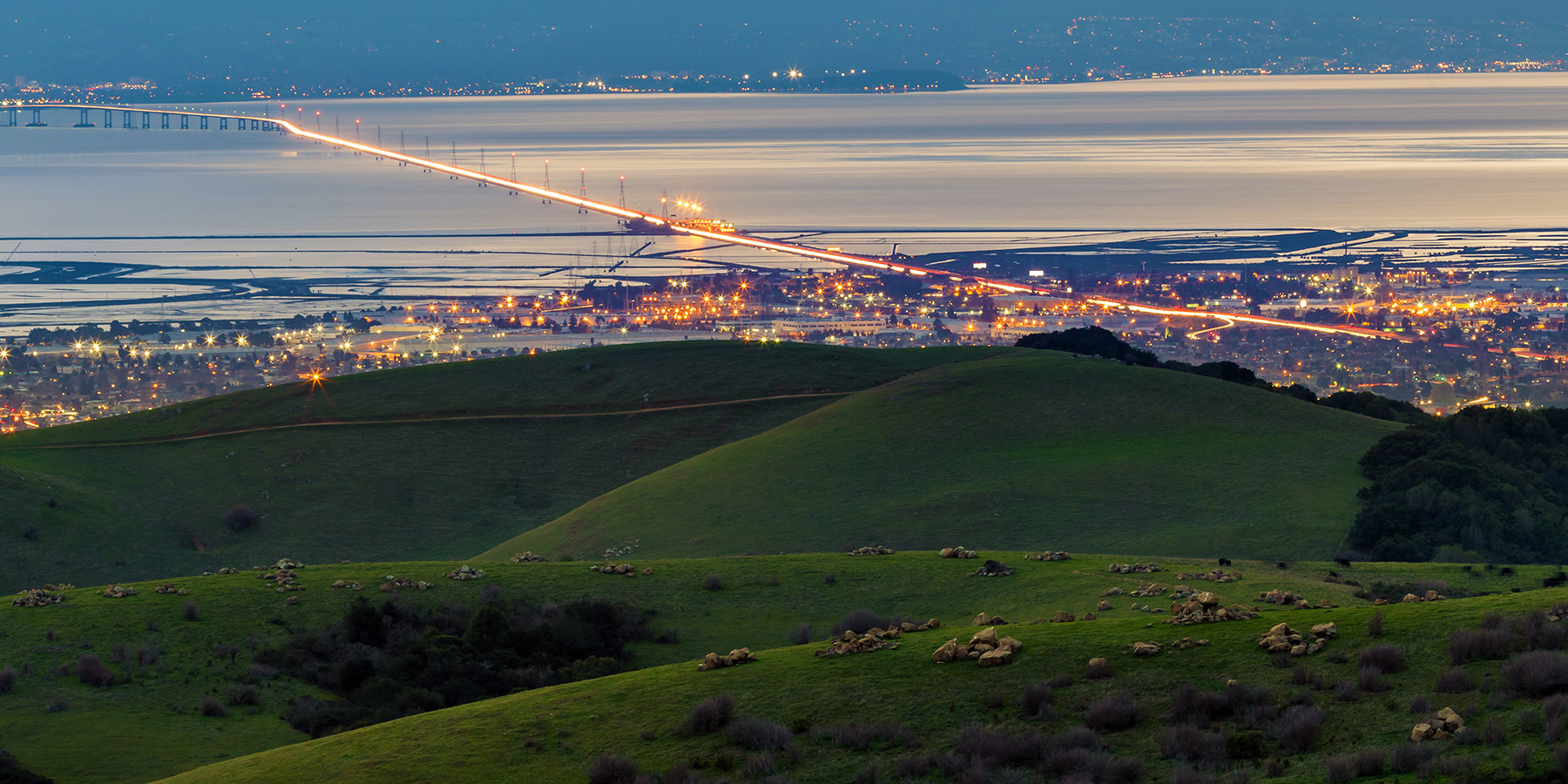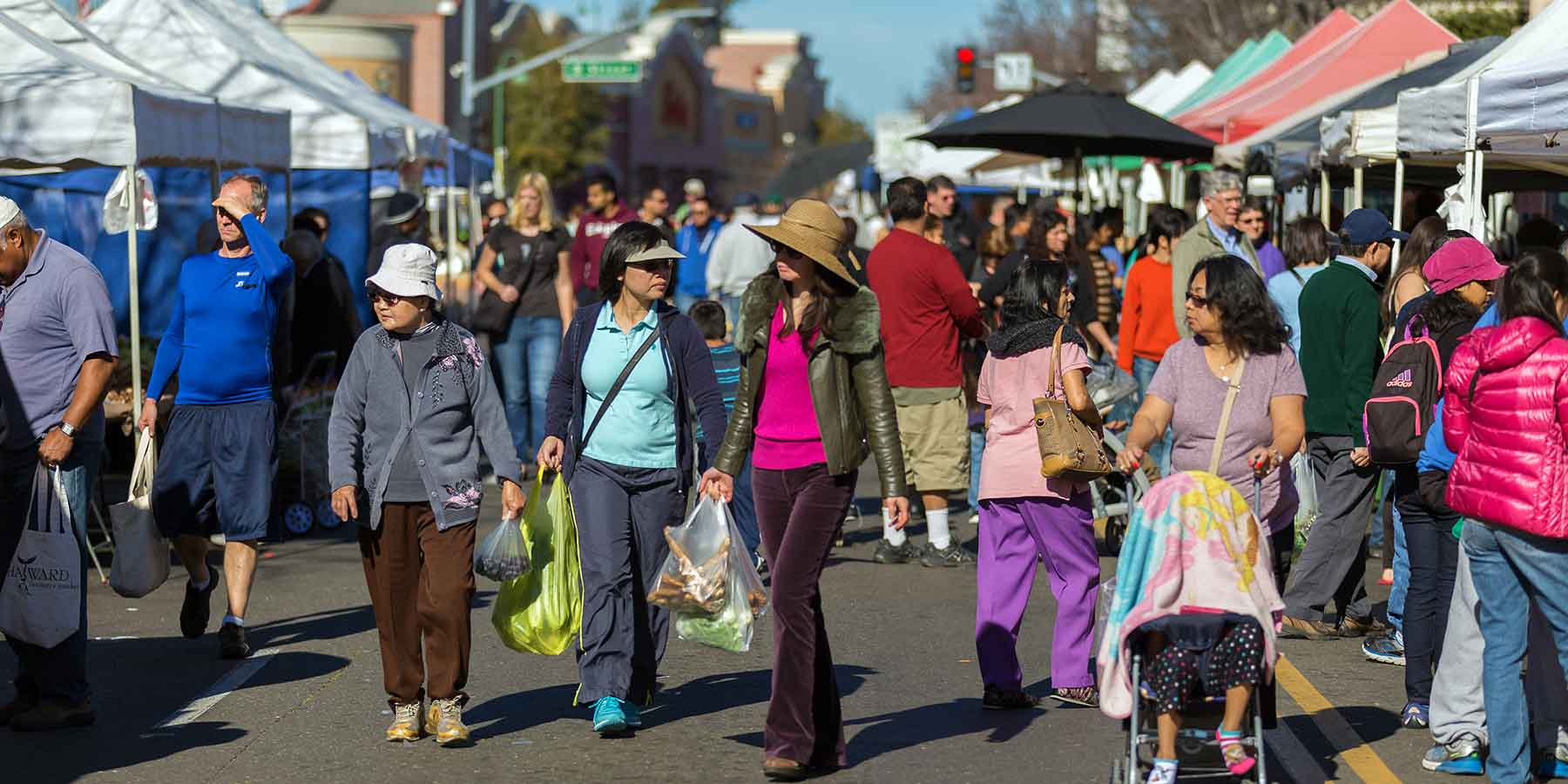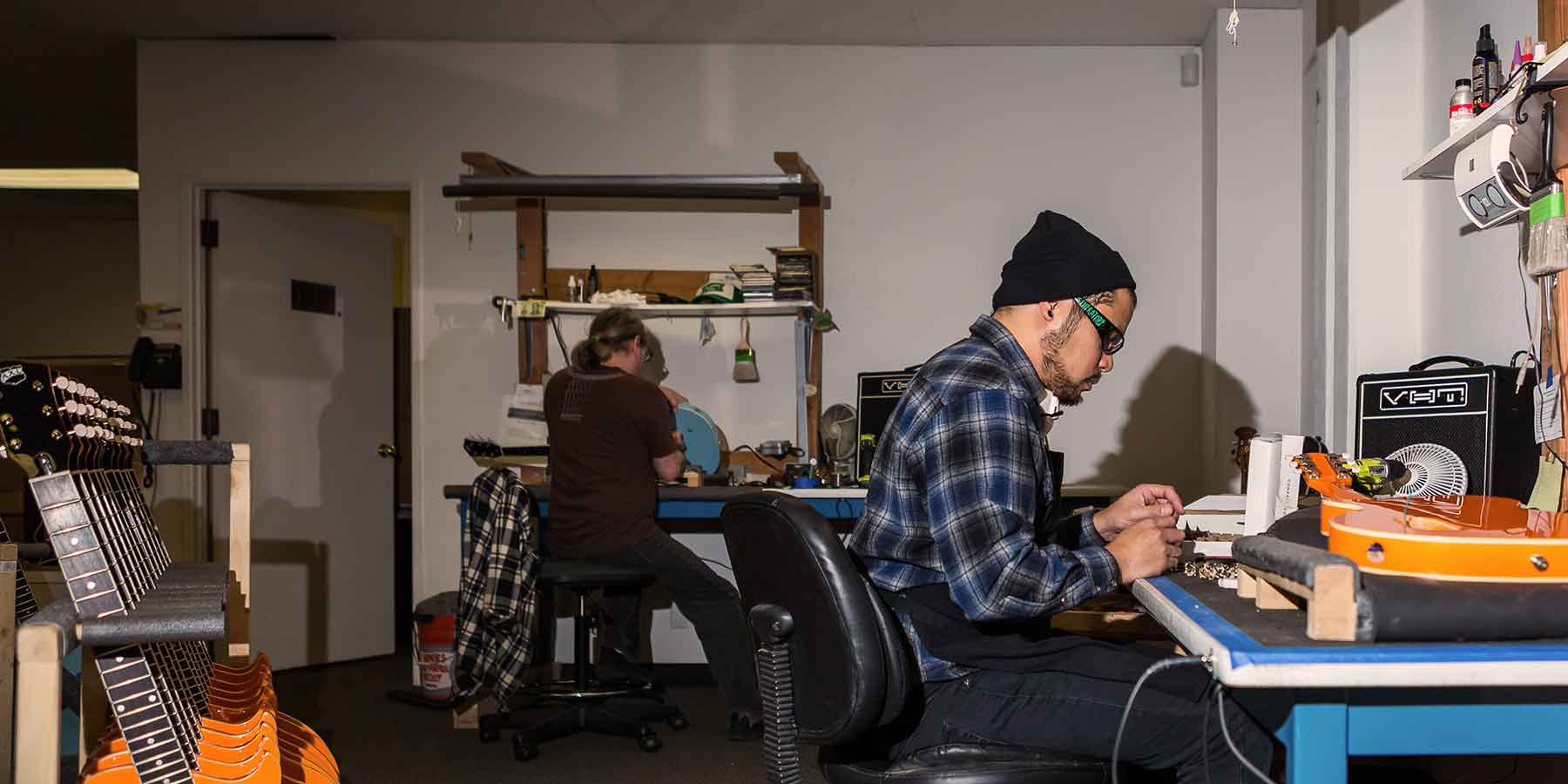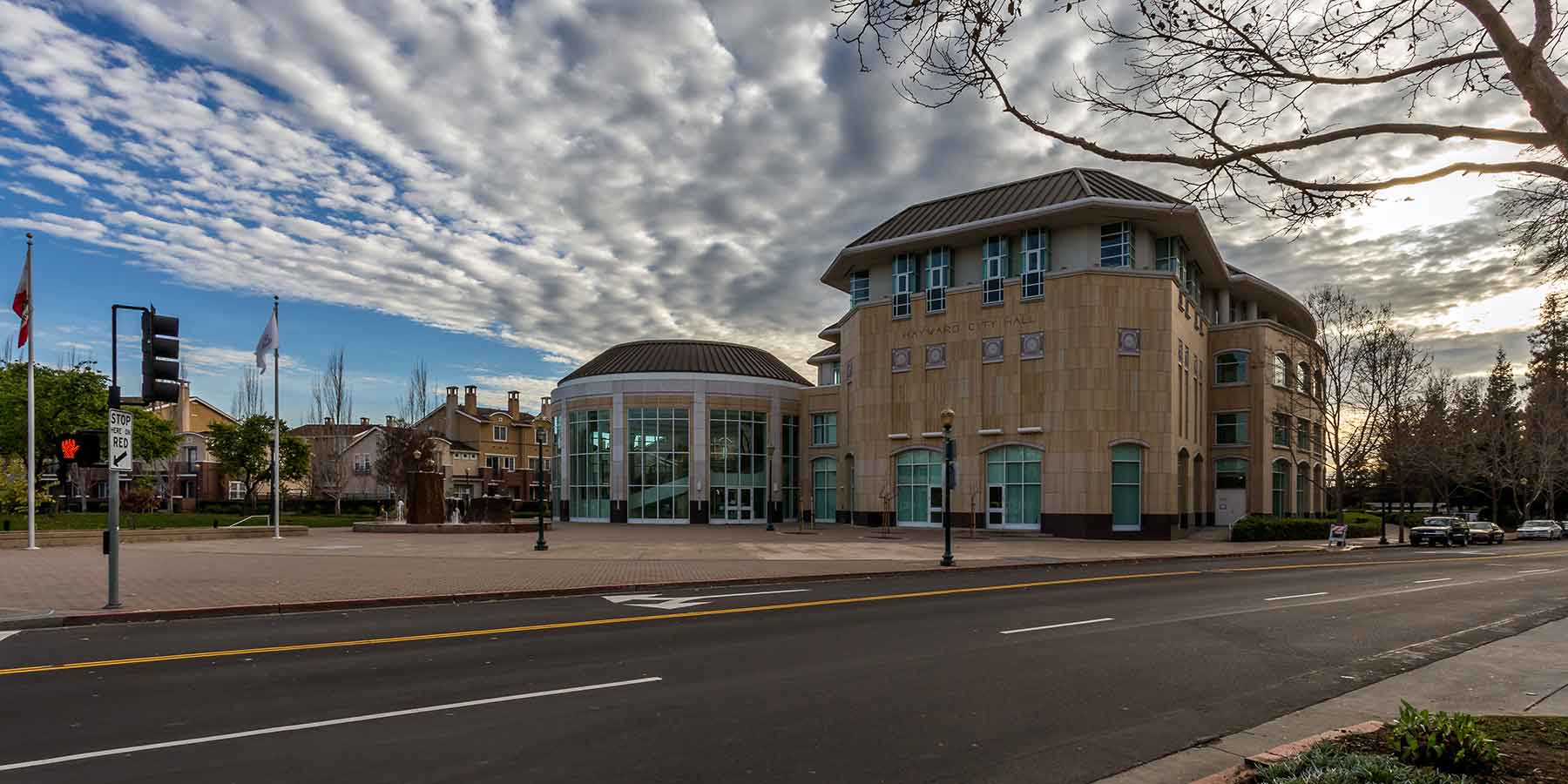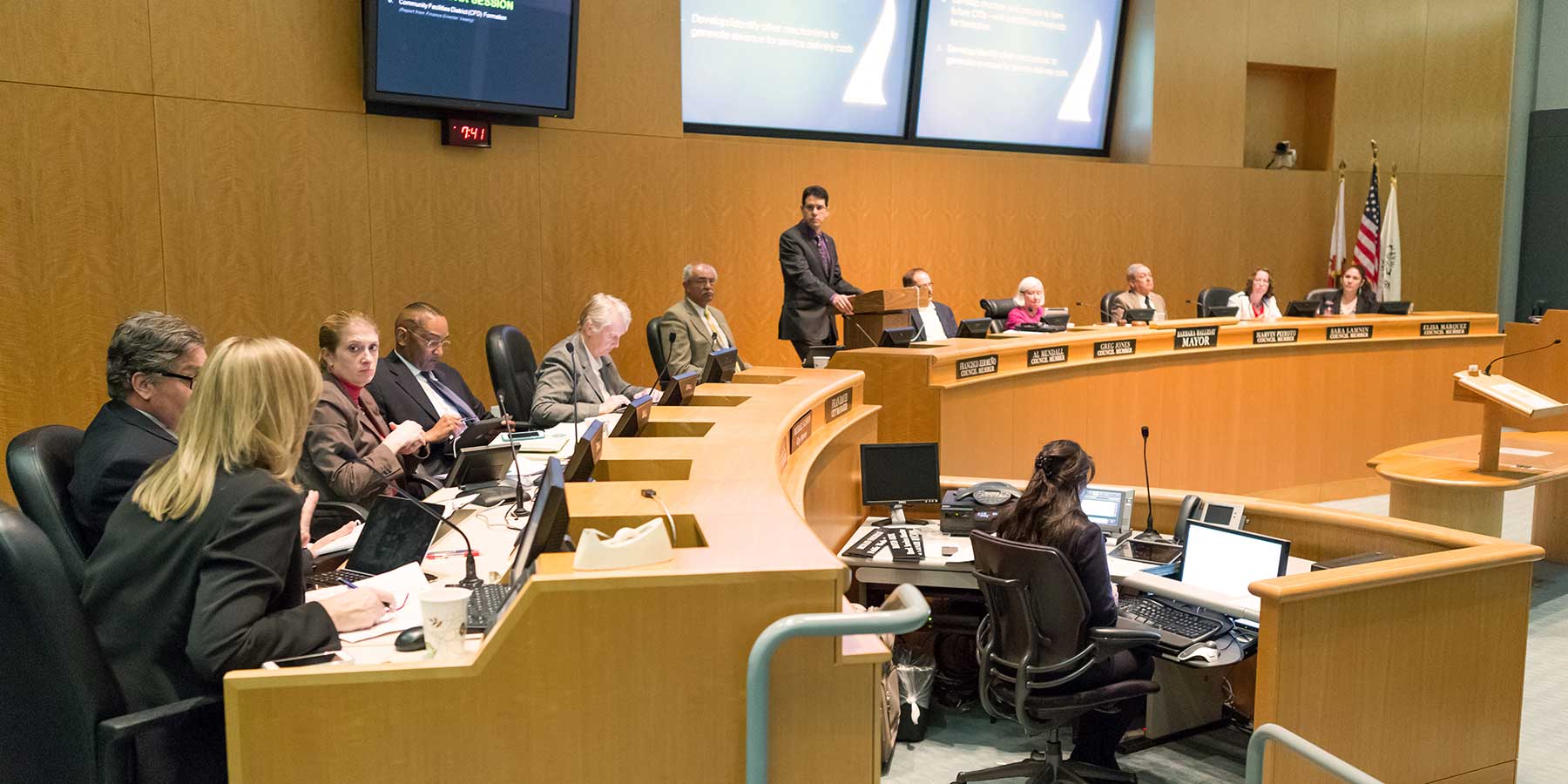Land Use & Community Character Element
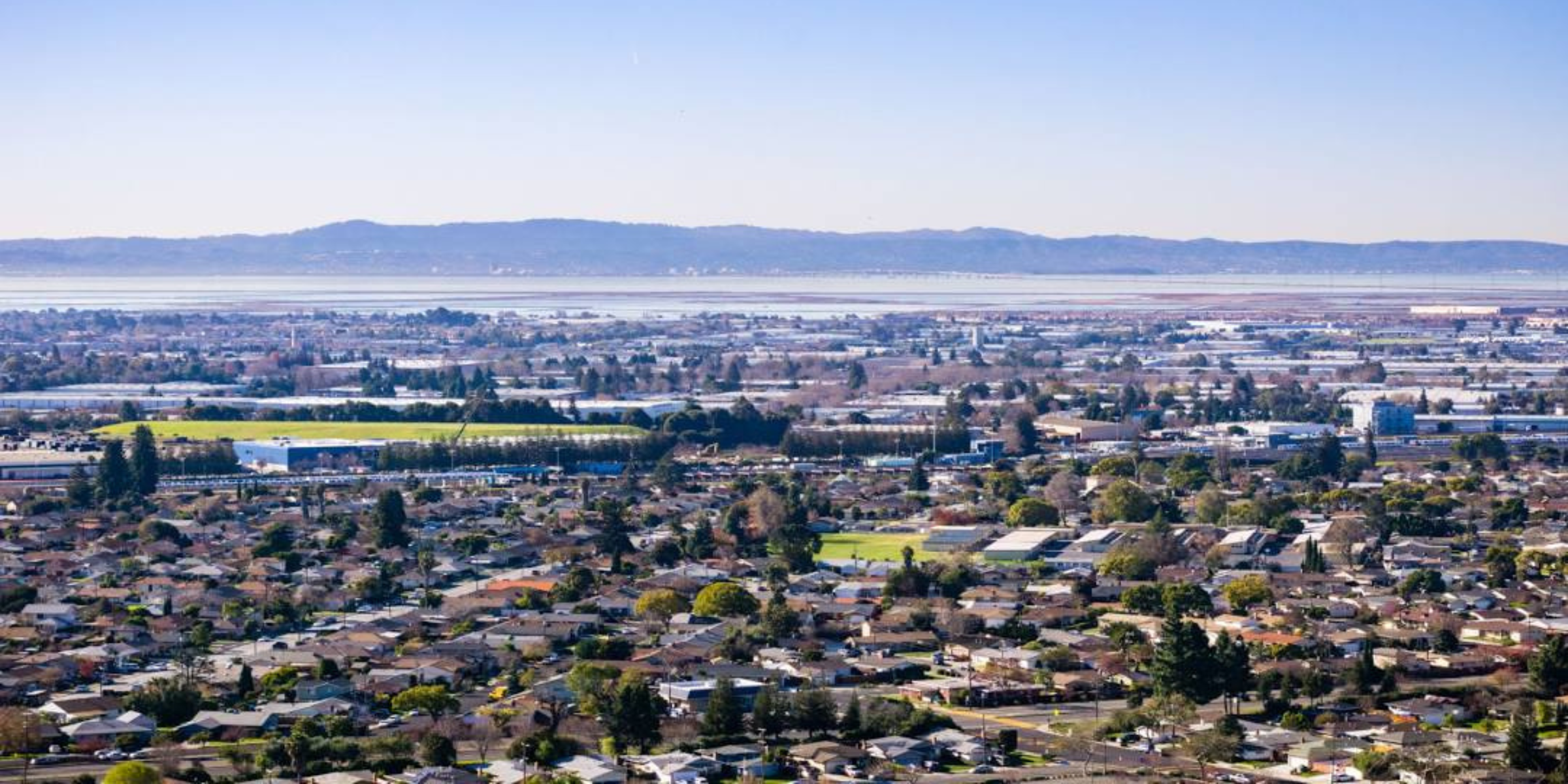
With the exception of Downtown Hayward and a few residential neighborhoods, the majority of Hayward neighborhoods and districts were developed during the post-World War II housing boom of the 1950s, 60s, and 70s.
As a result, the city’s land use patterns and urban design features are generally characterized by single-use neighborhoods and centers, low-density housing tracts, strip commercial centers, and auto-oriented street networks. In the 1990s and 2000s, the City of Hayward began a new era of land use planning and urban design based on the principles of “smart growth.”
The preservation of open space, infill development and revitalization, compact and mixed-use neighborhoods, pedestrian and bicycle-friendly streets, and transit-oriented developments are key principles of smart growth that the City of Hayward embraced and applied to planning and revitalization efforts for the Downtown, the Cannery Neighborhood, the South Hayward BART Station Neighborhood, and the Mission Boulevard Corridor.
To accommodate future population and employment growth and enhance Hayward’s overall quality of life, the City will continue to implement the principles of smart growth and sustainability, and seek opportunities to improve and revitalize the Downtown, established neighborhoods, corridors, and shopping centers. To diversify and expand Hayward’s economic base, the City will strive to further develop the Industrial Technology and Innovation Corridor with uses that create a healthy balance between a manufacturing-based economy and an information- and technology-based economy.
The Land Use and Community Character Element establishes goals and policies to strategically accommodate future growth and change while preserving and enhancing the qualities and characteristics that make Hayward a desirable place to live, work, learn, and play. The goals and policies are designed to enhance Hayward’s neighborhoods and districts with an attractive mix of uses and amenities that expand the local economy, enhance social interaction, protect environmental resources, and improve the overall quality of life of residents.
A variety of topics are discussed within the Element, including growth and sustainable development, the development of the city’s Priority Development Areas, the revitalization of corridors and centers, the development of complete neighborhoods, the enhancement of the Industrial Technology and Innovation Corridor, the design of hillside developments, the preservation of historic resources and districts, and the design of compatible public and quasi-public land uses.
The goals and policies of the Land Use and Community Character Element are closely related to several other elements of the General Plan, including the Mobility Element, Economic Development Element, and Community Health and Quality of Life Element.
The Land Use and Community Character Element is divided into two sections. The first section provides an overview of the General Plan Land Use Diagram and a description of the city’s land use designations. The Land Use Diagram establishes the overall pattern of planned land uses within the City and is closely aligned with the Transportation Diagrams provided in the Mobility Element. The second section of the Element presents the land use and community character goals and policies.
Land Use & Community Character Goals:
Goal LU-1: Promote local growth patterns and sustainable development practices that improve quality of life, protect open space and natural resources, and reduce resource consumption, traffic congestion, and related greenhouse gas emissions.
The Bay Area is projected to grow by an additional 2.0 million people and 1.1 million jobs by the year 2040. With its centralized Bay Area location and regional transportation network, the city of Hayward will undoubtedly receive a share of the region’s overall growth. This goal and its supporting policies are designed to promote sustainable development and local growth patterns that enhance Hayward’s overall quality of life.
Sustainable development is generally defined as an approach to land development that meets the needs of the current population without compromising the ability of future generations to meet their own needs. In more practical terms, a sustainable development project is designed and operated to minimize resource consumption, reduce dependency on the automobile, preserve sensitive environmental resources, reduce maintenance and utility expenses, and improve social health and interaction.
The policies in this section support growth patterns that protect Hayward’s open space and natural resources by maintaining established urban limit lines and directing housing and employment growth toward infill sites and underutilized properties. In addition, the policies in this section align with the Bay Area’s Regional Transportation Plan and Sustainable Communities Strategy by directing growth toward walkable and mixed-use areas that are planned to integrate housing with regional transit, employment, services, and amenities. These areas, which are called Priority Development Areas, are discussed further under Goal 2.
The policies in this section address growth and sustainable development at a city-wide level. Other goals in this Element provide more specific direction related to how growth and development should occur within the many neighborhoods, corridors, and centers of Hayward.
LU-1.1: Jobs-Housing Balance:
The City shall support efforts to improve the jobs-housing balance of Hayward and other communities throughout the region to reduce automobile use, regional and local traffic congestion, and pollution.
Jobs Housing Ratio—In 2010, the City of Hayward had a jobs-housing ratio of 1.43 jobs for every housing unit. The California Department of Finance considers a ratio of 1.5 jobs for every housing unit to be a healthy ratio.
LU-1.2: Urban limits Lines:
The City shall maintain its established Urban Limit Lines to protect the Hayward shoreline and hillsides as natural open space and recreational resources.
LU-1.3: Growth & Infill Development:
The City shall direct local population and employment growth toward infill development sites within the city, especially the catalyst and opportunity sites identified in the Economic Development Strategic Plan.
LU-1.4: Revitalization & Redevelopment:
The City shall encourage property owners to revitalize or redevelop abandoned, obsolete, or underutilized properties to accommodate growth.
LU-1.5: Transit-Oriented Development:
The City shall support high-density transit-oriented development within the city’s s to improve transit ridership and to reduce automobile use, traffic congestion, and greenhouse gas emissions.
LU-1.6: Mixed Use Neighborhoods:
The City shall encourage the integration of a variety of compatible land uses into new and established neighborhoods to provide residents with convenient access to goods, services, parks and recreation, and other community amenities.
LU1.7: Design Guidelines:
The City shall maintain and implement commercial, residential, industrial, and hillside design guidelines to ensure that future development complies with General Plan goals and policies.
LU-1.8: Green Building & Landscaping Requirements:
The City shall maintain and implement green building and landscaping requirements for private- and public-sector development to:
- Reduce the use of energy, water, and natural resources.
- Minimize the long-term maintenance and utility expenses of infrastructure, buildings, and properties.
- Create healthy indoor environments to promote the health and productivity of residents, workers, and visitors.
- Encourage the use of durable, sustainably-sourced, and/or recycled building materials.
- Reduce landfill waste by promoting practices that reduce, reuse, and recycle solid waste.
LU-1.9: Development Standards & Greenhouse Gas Emissions:
The City shall explore the use of zoning and development standards that help reduce greenhouse gas emissions when preparing or updating plans and ordinances.
LU-1.10: Iinfrastructure Capacities:
The City shall ensure that adequate infrastructure capacities are available to accommodate planned growth throughout the city.
LU-1.11: Annexations:
The City shall consider the annexation of adjoining unincorporated properties if the annexation would improve the fiscal health of the City, provide a more efficient delivery of City services to the area, and/or create a more logical City boundary.
LU-1.12: Regional Planning:
The City shall coordinate with regional and local agencies to prepare updates to regional growth plans and strategies, including the Bay Area’s Regional Transportation Plan, Sustainable Communities Strategy, and Regional Housing Needs Allocation (RHNA).
LU-1.13: Local Plan Consistency with Regional Plans:
The City shall strive to develop and maintain local plans and strategies that are consistent with the Regional Transportation Plan and the Sustainable Communities Strategy to qualify for State transportation funding and project CEQA streamlining.
LU1.14: Joint Planning with Alameda County:
The City shall coordinate with Alameda County in reviewing proposed developments and plans within the unincorporated areas of the City’s Sphere of Influence to ensure that they align with Hayward’s 2040 Vision.
Goal LU-2: Revitalize and enhance Hayward’s Priority Development Areas to accommodate and encourage growth within compact, mixed-use, and walkable neighborhoods and districts that are located near the city’s job centers and regional transit facilities.
The Bay Area’s Regional Transportation Plan and Sustainable Communities Strategy directs housing and employment growth toward Priority Development Areas located throughout the region. These areas include downtowns, employment centers, corridors, neighborhoods, and districts that are served by regional transit. Hayward has five Priority Development Areas:
- The Downtown City Center
- The Cannery Transit Neighborhood
- The Mission Boulevard Mixed-Use Corridor
- The South Hayward BART Mixed-Use Corridor
- The South Hayward BART Urban Neighborhood
This goal and its supporting policies encourage development within Hayward’s Priority Development Areas. Development within Hayward’s Priority Development Areas will decrease dependency on the automobile and allow more people to walk, bike, or take transit for commute and daily trips. This will help reduce automobile use, local and regional traffic congestion, and related greenhouse gas emissions.
The City of Hayward has adopted specific plans, area plans, or form-based codes for all of the Priority Development Areas. These plans and codes contain specific land use policies and design regulations for new development. With the exception of the Downtown City Center, the policies within this section support the implementation of these plans and codes to guide future development and infrastructure improvements within the Priority Development Areas. The adopted plan for the Downtown City Center is relatively dated and new policies, strategies, and regulations are needed to support Downtown investment and revitalization. As a result, this section provides more policies for the Downtown City Center than the other Priority Development Areas. A policy is also provided to support the development of an updated Specific Plan for the Downtown City Center.
LU-2.1: Downtown Arts & Entertainment:
The City shall encourage private-sector investment in Downtown to transform it into a safe, vibrant, and prosperous arts and entertainment district that offers enhanced shopping, dining, recreational, and cultural experiences and events for residents, families, college students, and visitors.
LU-2.2: Downtoan Activities & Functions:
The City shall maintain the Downtown as a center for shopping and commerce, social and cultural activities, and political and civic functions.
LU-2.3: Downtown Pedestrian Environment:
The City shall strive to create a safe, comfortable, and enjoyable pedestrian environment in the Downtown to encourage walking, sidewalk dining, window shopping, and social interaction.
LU-2.4: Downtown Retail Frontages:
The City shall require retail frontages and storefront entrances on new and renovated buildings within the “retail core” of Downtown Hayward, which includes properties along:
- “A” Street between Mission Boulevard and Foothill Boulevard
- “B” Street between Watkins Street and Foothill Boulevard
- “C” Street between Mission Boulevard and Foothill Boulevard
- Main Street between “A” Street and “C” Street
- Mission Boulevard between “A” Street and “C” Street
- Foothill Boulevard between “C” Street and City Center Drive
This policy does not apply to historic buildings that were originally designed without a retail frontage or storefronts.
LU-2.5: Downtown Housing:
The City shall encourage the development of a variety of urban housing opportunities, including housing units above ground floor retail and office uses, in the Downtown to:
- Increase market support for businesses,
- Extend the hours of activity,
- Encourage workforce housing for a diverse range of families and households,
- Create housing opportunities for college students and faculty, and
- Promote lifestyles that are less dependent on automobiles.
LU-2.6: Downtown BART Housing:
The City shall encourage a mix of commercial, office, high-density residential, and mixed-use development in the area surrounding the Downtown BART Station.
LU-2.7: Downtown Specific Plan:
The City shall develop, maintain, and implement a to establish a vision for Downtown Hayward and to guide and regulate future development and infrastructure improvements.
LU-2.8: South Hayward BART Urban Neighborhood & Mixed-Use Corridor:
The City shall encourage the development of vibrant, compact, mixed-use, and walkable urban neighborhoods within the South Hayward BART Neighborhood and the South Hayward BART Mixed-Use Corridor.
LU-2.9: South Hayward BART Form-Based Code:
The City shall maintain and implement the South Hayward BART to guide and regulate future development and infrastructure improvements within the South Hayward BART Neighborhood and the South Hayward BART Mixed-Use Corridor.
LU-2.10: The Cannery Transit Neighborhood:
The City shall encourage redevelopment of the remaining industrial parcels in the former Hunt’s Cannery Area to complete the urban neighborhood with a variety of residential uses, a network of parks, a school, and supporting commercial, office, and live-work uses.
LU-2.11: The Cannery Area Design Plan:
The City shall maintain and implement the Cannery Area Design Plan to guide and regulate future development and infrastructure improvements within The Cannery Transit Neighborhood.
LU-2.12: Mission Boulevard Mixed-Use Corridor:
The City shall encourage the redevelopment of the Mission Boulevard corridor to create an attractive mixed-use boulevard with a variety of commercial functions and residential densities that support walking and transit.
LU-2.13: Mission Boulevard Specific Plan:
The City shall maintain and implement the Mission Boulevard to guide and regulate development within the Mission Boulevard Mixed-Use Corridor.
LU-2.14: University-Orientated Uses:
The City shall support the development of university-oriented uses, including student and faculty housing, satellite campuses, and university-oriented retail and service uses, within the City’s s (excluding the Cannery Transit Neighborhood).
LU-2.15: Office & Employment Uses & Amenities:
The City shall encourage the establishment of professional office and employment uses within the s. Major office and employment uses should include amenities for employees, such as courtyards and plazas, outdoor seating areas, fitness facilities, bicycle storage areas, and showers.
LU-2.16: Uses top Attract the Creative Class:
The City shall encourage the development of uses and amenities to attract creative-class professionals and businesses to Hayward’s s, including:
- Restaurants and cafes;
- Art studios and galleries;
- Entertainment and cultural venues;
- housing and live-work units;
- Exercise and physical fitness facilities;
- Office space and business incubators; and
- Community-operated workspaces where people with common interests can meet, collaborate, and develop their business ideas and products (e.g. hacklabs, hackerspaces, or makerspaces).
LU-2.17: Youth & Family Entertainment:
The City shall encourage the establishment of youth and family entertainment uses within the Downtown and/or the Mission Boulevard Corridor. Appropriate uses include ice skating, climbing walls, bowling alleys, trampoline gyms, indoor miniature golf, arcades, billiards, climbing and play structures, water play or “spray parks”, and family-friendly dining.
LU-2.18: Future Priority Development Areas:
The City shall work with the Alameda County Transportation Commission and the Metropolitan Transportation Commission to consider establishing new Priority Development Areas during future updates to the Regional Transportation Plan and Sustainable Communities Strategy.
The Creative Class—Richard Florida, an economist and social scientist, coined the term "creative class" to describe a group of highly creative and innovative professionals that design goods and offer service to solve complex problems. The creative creative class includes scientists, engineers, educators, computer programmers, web designers, and media workers. According to Florida, the creative class is a key driving force of economic development within post-industrial cities throughout the United States. For a city to attract the creative class, Florida argues, that it must possess "the three 'T's": Talent: a highly talented, educated, and skilled populations; Tolerance: a diverse community that has a 'live and let live' ethos; and Technology (the technological infrastructure necessary to fuel an entrepreneurial culture).
LU-2.19: Unincorporated Priority Development Areas within the Hayward Planning Area:
The City shall coordinate with Alameda County to pursue joint planning efforts and to review future plans for County s that are located within the City’s (i.e., Hesperian Boulevard Transit Neighborhood, the Meekland Avenue Mixed-Use Corridor, and the East 14th Street and Mission Boulevard Mixed-Use Corridor).
Goal LU-3: Create complete neighborhoods that provide a mix of housing options and convenient access to parks, schools, shopping, jobs, and other community amenities.
Most of Hayward’s neighborhoods were developed under land use and zoning regulations that required the separation of land uses. As a result, many Hayward neighborhoods do not provide their residents with safe and convenient access to schools, parks, shopping, community services, and other neighborhood amenities. This goal and its supporting policies are designed to create more complete neighborhoods. Complete neighborhoods meet the daily needs of residents and provide a mix of amenities, including pedestrian- and bicycle-friendly streets, parks, community centers, day care centers, community gardens, affordable housing, libraries, and neighborhood commercial and service uses.
Supporting goals and policies related to complete neighborhoods are also provided in the Mobility Element and the Health and Quality of Life Element.
The policies in this section apply to most neighborhoods within the City. They do not apply to the City’s Priority Development Areas, as more specific policies for those areas are provided under Goal 2.
LU-3.1: Complete Neighborhoods:
The City shall promote efforts to make neighborhoods more complete by encouraging the development of a mix of complementary uses and amenities that meet the daily needs of residents. Such uses and amenities may include parks, community centers, religious institutions, daycare centers, libraries, schools, community gardens, and neighborhood commercial and mixed-use developments.
LU-3.2: Centralized Amenities:
The City shall encourage the development of neighborhood amenities and complimentary uses in central locations of the neighborhood whenever feasible.
LU-3.3: Neighborhood Commercial & Mixed-Use Developments:
The City shall allow neighborhood commercial and mixed-use developments on properties with residential land use designations, subject to community input from residents and conditions of approval that ensure that these uses are located, designed, and operated in a manner that maintains neighborhood compatibility and contributes to an enhanced quality of life.
Appropriate locations for neighborhood commercial and mixed-use developments include:
- Corner lots located along collector or arterial streets.
- Corner lots located adjacent to or across from a school, park, community center, or other neighborhood gathering place.
LU-3.4: Design of New Neighborhood Commercial & Mixed-Use Developments:
The City shall require new neighborhood commercial and mixed-use developments to have a pedestrian-scale and orientation by:
- Placing the building and outdoor gathering spaces along or near the sidewalk.
- Locating parking to the rear of the building or along the internal side yard of the property.
- Designing the building with ground floor retail frontages or storefronts that front the street.
- Enhancing the property with landscaping, lighting, seating areas, bike racks, planters, and other amenities that encourage walking and biking.
LU-3.5: Mixed-Density Development Projects:
The City shall encourage infill residential developments that provide a mix of housing types and densities within a single development on multiple parcels. Individual parcels within the development may be developed at higher or lower densities than allowed by the General Plan, provided that the net density of the entire development is within the allowed density range.
LU-3.6: Residential Design Strategies:
The City shall encourage residential developments to incorporate design features that encourage walking within neighborhoods by:
- Creating a highly connected block and street network.
- Designing new streets with wide sidewalks, planting strips, street trees, and pedestrian-scaled lighting.
- Orienting homes, townhomes, and apartment and condominium buildings toward streets or public spaces.
- Locating garages for homes and townhomes along rear alleys (if available) or behind or to the side of the front facade of the home.
- Locating parking facilities below or behind apartment and condominium buildings.
- Enhancing the front facade of homes, townhomes, and apartment and condominium buildings with porches, stoops, balconies, and/or front patios.
- Ensuring that windows are provided on facades that front streets or public spaces.
LU-3.7: Infill Development in Neighborhoods:
The City shall protect the pattern and character of existing neighborhoods by requiring new infill developments to have complimentary building forms and site features.
LU-3.8: Home Additions:
The City shall require home additions to be compatible with the mass, scale, and character of the existing home and neighborhood by using compatible building forms, materials, and features. Home additions along rear or side facades are encouraged.
LU-3.9: Home Conversations:
If residential homes are converted to non-residential uses, the City shall ensure that the property maintains the residential character of the neighborhood by minimizing changes to landscaped front yards and exterior building elevations, and requiring low-profile monument signs for businesses.
LU-3.10: Mobile Home Parks:
The City shall encourage private-sector investments to maintain local mobile homes parks, and shall discourage the conversion of mobile home parks to alternative uses.
LU-3.11: Gated Neighborhoods:
The City shall discourage gated neighborhoods to encourage social cohesion and to promote an interconnected and accessible street network that allows public access through all city neighborhoods.
Goal LU-4: Create attractive commercial and mixed-use corridors that serve people traveling through the city, while creating more pedestrian-oriented developments that foster commercial and social activity for nearby residents and businesses.
The city of Hayward has a variety of arterial streets that traverse the community. These arterial corridors are generally lined with auto-oriented commercial uses, such as gas stations, fast-food restaurants, and a variety of strip commercial developments. The land uses and development patterns along Hayward’s corridors generally serve motorist driving through the neighborhood or city.
Most of the commercial properties do not offer convenient access and attractive amenities that encourage nearby residents and employees to walk or bike to businesses and services. Some corridor segments are also lined with blighted properties and residential sound walls and fences. These areas are targets for litter and graffiti, which degrade the image and perceived safety of the city.
This goal and its supporting policies are designed to reinvent Hayward’s corridors to create more attractive and economically viable uses. Rather than creating conditions that exclusively serve motorists driving through the neighborhood or city, the policies support efforts to create more pedestrian-oriented developments that foster commercial and social activity for nearby residents and employees.
Supporting policies related to complete and multi-modal streets are provided in the Mobility Element.
The policies in this section apply to the majority of corridors within the City. They do not apply to corridor segments within the City’s Priority Development Areas and Industrial Technology and Innovation Corridor. Policies for the Priority Developments Areas and the Industrial Technology and Innovation Corridor are provided under Goal 2 and Goal 6, respectively.
LU-4.1: Mixed-Use Corridors:
The City shall encourage a variety of development types and uses along corridors to balance the needs of residents and employees living and working in surrounding areas with the needs of motorists driving through the community.
LU-4.2: Transformation of Auto-Oriented & Strip Commercial Uses:
The City shall support the transformation of auto-oriented and strip commercial uses into attractive pedestrian-oriented developments that frame and enhance the visual character of the corridor.
LU-4.3: Mixed-Use Developments within Commercial-Zoned Properties:
The City shall allow mixed-use developments within commercially-zoned properties along corridors and ensure that these uses are located, designed, and operated in a manner that maintains compatibility with adjacent residential uses.
LU-4.4: Design Strategies for Corridors Developments:
The City shall encourage corridor developments to incorporate the following design strategies:
- Widen and improve public sidewalks to accommodate street trees, pedestrian-scaled lighting, and streetscape furniture. When sidewalks cannot be widened within the public right-of-way, the City shall encourage developers to extend sidewalk improvements on private property to create room for improvements.
- Place buildings and outdoor gathering and dining spaces along or near the public sidewalk of the corridor.
- Locate parking lots to the rear or side of buildings or place parking within underground structures or above-ground structures located behind buildings.
- Design commercial and mixed-use buildings with articulated facades and transparent storefront entrances that front the corridor.
- Design residential buildings with articulated facades and entries that front the corridor.
- Enhance commercial and mixed-use building facades with awnings, shade structures, pedestrian-oriented signage, decorative lighting, and other attractive design details and features.
- Enhance residential building facades with stoops, porches, balconies, and other attractive design details and features.
LU-4.5: Massing, Height, and Scale:
The City shall require corridor developments to transition the massing, height, and scale of buildings when located adjacent to residential properties. New development shall transition from a higher massing and scale along the corridor to a lower massing and a more articulated scale toward the adjoining residential properties.
LU-4.6: Commerical Signs:
The City shall maintain, implement, and enforce sign regulations and design standards to reduce sign clutter and illegal signage along corridors.
LU-4.7: Parcel Consolidation:
The City shall promote the consolidation of small and irregular shaped parcels along corridors to improve the economic feasibility of development projects.
LU-4.8: Shared Driveways & Parking Lots:
The City shall encourage adjoining properties along corridors to use shared driveways and shared parking lots to promote the efficient use of land, reduce the total land area dedicated to parking, and to create a more pedestrian-friendly environment by minimizing curb-cuts along the sidewalk.
LU-4.9: Existing Sound Walls & Fences:
The City shall encourage landscaping improvements along sound walls and fences to discourage graffiti and to enhance the visual character of corridors. Where landscaping is not feasible, the City shall encourage the painting of murals on sound walls.
LU-4.10: New Sound Walls & Fences:
The City shall discourage the construction of new soundwalls and fences along corridors and shall encourage new developments to front corridors whenever feasible. This policy does not apply to the reconstruction of existing soundwalls or fences that shield existing residential uses from noise.
LU-4.11: Streetscape Enhancements:
The City shall strive to improve the visual character of corridors by improving streetscapes with landscaped medians, and widened sidewalks that are improved with street trees, pedestrian-scaled lighting, underground utilities, landscaping, and streetscape furniture and amenities.
LU-4.12: Hesperian Boulevard College Corridor:
The City shall develop, maintain, and implement a plan to create a mixed-use and pedestrian-oriented corridor along the segment of Hesperian Boulevard near Chabot College (between Winton Avenue and State Route 92). The City shall encourage a variety of student- and neighborhood-oriented uses along the corridor, including student housing, restaurants, entertainment uses, and cafes.
LU-4.13: "A" Street & Redwood Road Corridor:
The City shall coordinate with Alameda County to prepare a coordinated corridor enhancement and land use plan for the “A” Street and Redwood Road Corridor.
LU-4.14: Grants for Corridor Planning:
The City shall pursue grant funding to prepare land use, urban design, and mobility plans for additional corridors in Hayward.
LU-4.15: Gateway Monument Signs:
The City shall provide gateway monument signs or archways at major corridor entrances to the city, including:
- Mission Boulevard (at the north and south City Limits),
- Hesperian Boulevard (at the north and south City Limits),
- Foothill Boulevard (at the north City Limit),
- “A” Street and Redwood Road (at the north City Limit),
- B Street (at the northeast City Limit), and
- Industrial parkway Southwest (at the south City Limit).
Goal LU-5: Promote attractive and vibrant community and regional centers that provide convenient and enhanced opportunities for shopping, services, entertainment, social interaction, and culture.
Centers are commercial and mixed-use developments that contain a mix of commercial businesses and at least one anchor tenant. For the purpose of this General Plan, the City of Hayward has two types of centers: regional centers and community centers. Regional centers, such as the Southland Mall, are large commercial developments that serve residents from Hayward and other nearby communities in Alameda County.
Regional centers are generally located at the intersections of major arterial streets and near freeway interchanges. Community centers are smaller commercial developments that primarily serve local residents and business within nearby neighborhoods. Community centers are typically located along arterial streets. As a result, they may be confused with corridor developments (see Goal 4).
The key differences between community centers and corridor developments are the size of the property and the tenant mix. Community centers are larger properties that contain a mix of commercial businesses and at least one anchor tenant, such as a grocery store or large health gym. Corridor developments are located on smaller sites and do not have an anchor tenant.
This goal and its supporting policies are designed to promote attractive and vibrant regional and community centers that provide opportunities for commerce, shopping, services, entertainment, and culture. The policies support the renovation, reuse, and redevelopment of underutilized and obsolete centers to create more economically viable developments. In some circumstances, residential and mixed-use developments may be appropriately integrated within existing and new centers to improve the economic viability of properties. However, the integration of these uses should support, rather than replace, the primary commercial and service functions of the center.
Because of the continuing growth of online retailing, convenience and experience are becoming more and more important in the design of regional and community centers. To attract customers and drive sales, centers need to give people additional reasons to visit. As a result, centers are being reinvented to enhance the social experience of shopping by offering quality indoor and outdoor spaces, wireless networks, quality dining experiences, and community gathering spaces, such as sidewalk dining, play areas for children, and plazas for community events. The policies in this section support these types of improvements and enhancements to existing and new centers.
The policies in this section apply to most centers within the City. They do not apply to the centers within the City’s Priority Development Areas, as more specific policies for those areas are provided under Goal 2.
LU-5.1: Mix of Uses & Activities:
The City shall encourage a mix of retail, service, dining, recreation, entertainment, and cultural uses and activities in regional and community centers to meet a range of neighborhood and citywide needs.
LU-5.2: Flexible Land Use Regulations:
The City shall maintain flexible land use regulations that allow the establishment of economically productive uses in regional and community centers.
LU-5.3: design Strategies for New Centers:
The City shall encourage new and redeveloped centers to incorporate the following design strategies:
- Place large anchor retail buildings (big-box stores) to the rear of the site and away from streets.
- Place smaller commercial or mixed-use buildings along street frontages and/or internal driveways that function as small pedestrian-oriented “Main Street” environments. Orient the main entrances to these buildings toward streets rather than internal parking lots.
- Minimize large expanses of parking along streets by placing parking lots and structures behind buildings and within the interior of the site.
- Encourage pedestrian-friendly sidewalks and outdoor gathering and dining spaces along building frontages.
- Incorporate pedestrian connections and access routes to connect building entrances to adjacent sidewalks, transit stops, parks and greenways, and neighborhoods.
- Design buildings with articulated facades and transparent storefront entrances.
- Enhance building facades with awnings, shade structures, pedestrian-oriented signage, decorative lighting, and other attractive design details and features.
LU-5.4: Parking Lot Enhancements:
The City shall require new and renovated community and regional centers to incorporate landscaping and shade trees into parking lots to capture and filter stormwater runoff, minimize the heat island affect, and improve the visual appearance of properties. Parking lot shade structures with solar panels may also be used as an alternative to shade trees.
LU-5.5: Southland Mall:
The City shall support private-sector efforts to improve the economic health and vitality of the Southland Mall, including major redevelopment efforts that transform the property into a regional destination for shopping, dining, and family and youth entertainment and recreation.
LU-5.6: Adaptive, Reuse, Renovation or Redevelopment:
The City shall support the adaptive reuse, renovation, or redevelopment of community and regional shopping centers that are no longer viable due to changing market conditions, demographics, or retail trends. The City shall consider alternative land uses if market conditions limit the feasibility of commercial uses.
LU-5.7: Integrating Centers with Residential or Mixed-Use Developments:
The City shall consider the integration of residential or mixed-use developments into new and existing community and regional centers. The integration of these uses should support, rather than replace, the primary commercial and service functions of the center.
Goal LU-6: Enhance the Industrial Technology and Innovation Corridor to expand the economic and employment base of Hayward and to achieve a healthy balance between a manufacturing-based economy and an information- and technology-based economy.
The Industrial Technology and Innovation Corridor is a crescent-shaped corridor located along the western and southwestern edge of the City’s Urban Limit Line. Due to its centralized Bay Area location, freeway access, and relatively low land costs, the Industrial Technology and Innovation Corridor has attracted a variety of warehouse and distribution facilities, food manufacturing companies, bio-technology firms, and high technology businesses.
As the main employment area of the city, the Corridor is an important economic asset that needs to be protected and enhanced. This goal and its supporting policies are designed to maintain and improve the Industrial Technology and Innovation Corridor and expand the economic and employment base of Hayward. The policies support land use changes that will help Hayward transition from a manufacturing-based economy to an information- and technology-based economy.
Supporting goals and policies related to the Industrial Technology and Innovation Corridor are provided in the Economic Development Element and Mobility Element. Additional policies related to the regulation of industrial uses that involve hazardous materials are provided under Goal HAZ-6 of the Hazards Element.
LU-6.1: Land Uses:
The City shall encourage employee-intensive uses, such as professional office, corporate campuses, research and development, traditional and specialized manufacturing, throughout the Industrial Technology and Innovation Corridor.
LU-6.2: Industrial & Warehouse Conversations:
The City shall encourage the conversion of obsolete industrial and warehouse distribution space to a productive use, such as advanced manufacturing, professional office centers, corporate campuses, research and development parks, and flex space.
LU-6.3: Parcel Consolidation:
The City shall promote the consolidation of small and irregular shaped parcels within the Industrial Technology and Innovation Corridor to improve the economic feasibility of development projects.
LU-6.4: Incidental Commercial Uses:
The City shall encourage incidental commercial uses that support employees and businesses within the Industrial Technology and Innovation Corridor, such as restaurants, business services, business hotels, gas stations, and similar uses.
LU-6.5: Incompatible Uses:
The City shall protect the Industrial Technology and Innovation Corridor from the encroachment of uses that would impair industrial operations or create future land use conflicts.
LU-6.6: Property Upgrades:
The City shall encourage property owners to upgrade existing buildings, site facilities, and landscaped areas to improve the economic viability of properties and to enhance the visual character of the Industrial Technology and Innovation Corridor.
LU-6.7: Design Strategies:
The City shall encourage developments within the Industrial Technology and Innovation Corridor to incorporate the following design strategies:
- Provide attractive on-site landscaping and shade trees along street frontages and within employee and visitor parking lots.
- Screen areas used for outdoor storage, processing, shipping and receiving, and other industrial operations with a combination of landscaping and decorative fences or walls.
- Encourage consistent architectural facade treatments on all sides of buildings.
- Screen roof-top equipment with roof parapets.
- Design shipping and receiving areas and driveways to accommodate the turning movements of large trucks.
- Develop coordinated and well-designed signage for tenant identification and way-finding.
- Incorporate attractive building and site lighting to prevent dark pockets on the site.
- Provide pedestrian walkways to connect building entrances to sidewalks.
- Use landscaped buffers with trees and attractive sound walls to screen adjacent residential areas and other sensitive uses.
LU-6.8: Employee Amenities:
The City shall encourage the provision of employee-serving amenities for major employment uses within the Industrial Technology and Innovation Corridor, such as courtyards and plazas, outdoor seating areas, fitness facilities, bicycle storage areas, and showers.
LU-6.9: Industrial Technology & Innovation Corridor Assessment District:
The City shall encourage the creation of an assessment district or other funding mechanisms to implement streetscape improvements and enhanced transit or shuttle service within the Industrial Technology and Innovation Corridor.
Goal LU-7: Preserve the rural and natural character of hillside development areas.
Hayward contains a number of unique hillside neighborhoods and hillside developments. This goal and its supporting policies are designed to preserve the rural and natural character of hillside development areas. The policies in this section support hillside developments that are sensitively located and designed to retain natural slopes, ridgelines, and sensitive habitat areas. They also require developments to provide connections to adjacent open space and trail networks.
Additional policies related to hillside development, such as landslide hazards and wildland fires, are provided under Goal HAZ-1 and Goal HAZ-5 of the Hazards Element.
LU-7.1: Slopes:
The City shall prohibit the construction of buildings on unstable and steep slopes (slopes greater than 25 percent).
LU-7.2: Ridgelines:
The City shall discourage the placement of homes and structures near ridgelines to maintain natural open space and preserve views. If ridgeline development cannot be avoided, the City shall require grading, building, and landscaping designs that mitigate visual impacts and blend the development with the natural features of the hillside.
LU-7.3: Hillside Street Layouts:
The City shall require curvilinear street patterns in hillside areas to respect natural topography and minimize site grading.
LU-7.4: Hillside Street Design:
The City shall encourage narrow streets in hillside areas. Streets should be designed with soft shoulders and drainage swales (rather than sidewalks with curbs and gutters) to maintain the rural character of hillside areas and minimize grading impacts. The City shall prohibit parking along narrow street shoulders to provide space for residents to walk and ride horses.
LU-7.5: Clustered Developments:
The City shall encourage the clustering of residential units on hillsides to preserve sensitive habitats and scenic resources as natural open space. Sensitive areas and scenic resources include woodlands, streams and riparian corridors, mature trees, ridgelines, and rock outcroppings.
LU-7.6: Open Spaces Access:
The City shall require new hillside developments to provide public trail access (as appropriate) to adjacent greenways, open space corridors, and regional parks.
LU-7.7: De-Annexations:
The City shall consider de-annexing properties outside of the City’s sphere of influence (e.g., Pleasanton Ridgeline) if cooperative agreements with Alameda County, Pleasanton, and the East Bay Regional Park District are in place to permanently preserve the properties as open space or regional parkland.
Goal LU-8: Preserve Hayward’s historic districts and resources to maintain a unique sense of place and to promote an understanding of the regional and community history.
Historic preservation greatly enhances a community’s overall sense of place and quality of life. Not only does it help residents and visitors appreciate local history, but it also helps to revitalize and stabilize downtowns, business districts, and neighborhoods. Historic preservation efforts can also produce local jobs, promote heritage tourism, and increase local property values.
This goal and its supporting policies strive to preserve Hayward’s many unique historic resources, including its civic and commercial buildings, and colonial, Victorian and Queen Anne homes and cottages. The policies also support the establishment of historic districts to preserve the character of Downtown Hayward, the Upper B Street District, the B Street Historic Streetcar District, and the Prospect Hill Historic Neighborhood.
LU-8.1: Value of Historic Preservation:
The City shall recognize the value and co-benefits of local historic preservation, including job creation, economic development, increased property values, and heritage tourism.
LU-8.2: Local Preservation Programs:
The City shall strive to enhance its local historic preservation programs to qualify for additional preservation grants and financing programs.
LU-8.3: Historic Preservation Ordinance:
The City shall maintain and implement its Historic Preservation Ordinance to safeguard the heritage of the city and to preserve historic resources.
LU-8.4: Survey & Historic Reports:
The City shall maintain and expand its records of reconnaissance surveys, evaluations, and historic reports completed for properties located within the city.
LU-8.5: Flexible Land Use Standards:
The City shall maintain flexible land use standards to allow the adaptive reuse of historic buildings with a variety of economically viable uses, while minimizing impacts to the historic value and character of sites and structures.
LU-8.6: Historic Preservation Standards & Guidelines:
The City shall consider The Secretary of the Interior's Standards for the Treatment of Historic Properties with Guidelines for Preserving, Rehabilitating, Restoring, and Reconstructing Historic Buildings when evaluating development applications and City projects involving historic resources, or development applications that may affect scenic views or the historic context of nearby historic resources.
LU-8.7: Historic Districts:
The City shall encourage the establishment of National Park Service Certified Historic Districts to encourage the preservation of Hayward’s historic neighborhoods and districts, and to qualify property owners for the Federal Preservation Tax Incentives Program.
LU-8.8: Marks Historic Rehabilitation District:
The City shall maintain the current Marks Historic Rehabilitation District for Downtown Hayward to issue tax-exempt revenue bonds for financing the rehabilitation of historic structures.
LU-8.9: State Historic Building Code:
The City shall promote the use of the State Historic Building Code to facilitate the reuse and conversion of historic buildings to alternative uses.
LU-8.10: Mills Act:
The City shall participate in the California Mills Act Property Tax Abatement Program to provide property owners of historic resources an economic incentive (property tax relief) to restore, preserve, and maintain qualified historic properties.
LU-8.11: Federal Historic Preservation Tax Incentives:
The City shall promote the use of the Federal Historic Preservation Tax Incentives Program to encourage the rehabilitation of income-producing historic structures in Hayward.
LU-8.12: Federal Historic Preservation Tax Credit Program:
The City shall promote the Federal Historic Preservation Tax Credit Program to encourage the charitable contribution of historic resources and the establishment of conservation easements for historic preservation purposes.
LU-8.13: Planning Study Considerations:
The City shall consider historical and cultural resources when developing planning studies and documents.
LU-8.14: Demolition of Historic Resources:
The City shall prohibit the demolition of historic resources unless one of the following findings can be made:
- The rehabilitation and reuse of the resource is not structurally or economically feasible.
- The demolition is necessary to protect the health, safety, and welfare of the public.
- The public benefits of demolition outweigh the loss of the historic resource.
Goal LU-9: Provide quality public and quasi-public uses that benefit residents and businesses and enhance the city’s overall quality of life and economic viability.
Hayward has a variety of public and quasi-public uses, including government facilities, college campuses, medical centers, and a municipal airport. This goal and its supporting policies are designed to ensure that public and quasi-public land uses enhance the quality of life of residents and meet the service needs of the community. Policies encourage public and quasi-public uses to be designed and operated in a manner that is compatible with surrounding properties.
Similar policies that are related to medical centers, parks and recreation, and senior care facilities are provided in the Health and Quality of Life Element.
LU-9.1: Design of City Public Facilities:
The City shall ensure that all City-owned facilities are designed to be compatible in scale, mass, and character with the neighborhood, district, or corridor in which they are located.
LU-9.2: Design of Non-City Public Facilities:
The City shall coordinate with school districts, park districts, utility providers, and other government agencies that are exempt from local land use controls to encourage facility designs that are compatible in scale, mass, and character with the neighborhood, district, or corridor in which they are located.
LU-9.3: Medical Centers:
The City shall coordinate with the owners of existing and planned medical centers to encourage site development or redevelopment in a manner that is compatible with surrounding areas.
LU-9.4: Alameda County Government Center:
The City shall encourage the expansion and enhancement of the Alameda County Government Center area on Winton Avenue to increase employment opportunities and provide additional services and amenities to employees and residents.
LU-9.5: Cal State University, East Bay:
The City shall coordinate with California State University, East Bay to encourage campus development that:
- Maintains compatibility with adjacent residential areas,
- Improves access routes to the campus,
- Protects sensitive habitat and steep slopes as open space,
- Provides additional student and faculty housing and services on campus,
- Supports the City’s economic development policies and programs,
- Enhances opportunities for students, residents, and visitors to experience arts, culture, recreation, and entertainment, and
- Promotes sustainable design and maintenance practices.
LU-9.6: Chabot College:
The City shall coordinate with Chabot College to encourage campus development that maintains compatibility with adjacent residential areas, promotes sustainable design and maintenance practices, and mitigates neighborhood compatibility issues, such as student parking on city streets.
LU-9.7: Hayward Municipal Airport:
The City shall maintain and implement an airport master plan to guide the long-term development of the Hayward Municipal Airport.
LU-9.8: Co-location of Public & Quasi-Public Uses:
The City shall encourage the co-location of public and quasi-public uses within commercial and mixed-use developments.
State planning law requires a general plan to describe the general distribution, location, and extent of planned land uses within the jurisdiction’s planning area. The General Plan Land Use Diagram uses color-coded land use designations to express the intended use of land across the Hayward (see Figure LU-1). For most properties, the land use designation shown on the Land Use Diagram matches the current land use of the property. This indicates that the City does not expect the use of the property to change. On other properties, the land use designation is different from the current use of the property. This indicates that the City expects the land use of the property to change as Hayward grows and develops between now and 2040.
A total of 19 land use designations are shown on the Land Use Diagram. This includes seven residential designations, two commercial designations, four mixed-use designations, two industrial designations, three open space designations, and one public and quasi-public designation. A description of each land use designation follows the Land Use Diagram. The descriptions include density and intensity standards to regulate development within each land use designation. A summary table of development standards for each land use designation is provided after the land use descriptions.
The Land Use Diagram is largely implemented through the City’s zoning regulations. Each land use designation has a corresponding set of compatible zoning districts. Many of the land use designations have more than one corresponding zoning district, which allows a more detailed interpretation of the Land Use Diagram based on existing uses and neighborhood conditions. Whereas the land use designations are intentionally broad, the zoning designations are more detailed and provide a variety of detailed development standards, including permitted and conditional uses, building heights, setbacks, lot coverage, and parking requirements. While the Land Use Diagram guides zoning, it is not the same as the City’s Map. By definition, the Land Use Diagram is intended to be more general than the Map.
Because land use designations may not reflect specific property and neighborhood conditions, they should not be interpreted to either propose or preclude land uses or developments without consideration of the guiding principles, goals, and policies of the General Plan. Site considerations related to topography, geology, or historic preservation may be more important in establishing the specific use and intensity of a particular parcel than the parcel’s specified land use designation. Similarly, the goals and policies of the General Plan may support certain types of uses that are not specifically listed within the description of the property’s land use designation. Therefore, the guiding principles, goals, and policies should always be reviewed to determine if a proposed use or development is consistent with the General Plan.
Requests to amend the Land Use Diagram are subject to a public process involving the Planning Commission and City Council. Amendments are also subject to evaluation under the California Environmental Quality Act (CEQA).
View the Interactive Land Use Map


